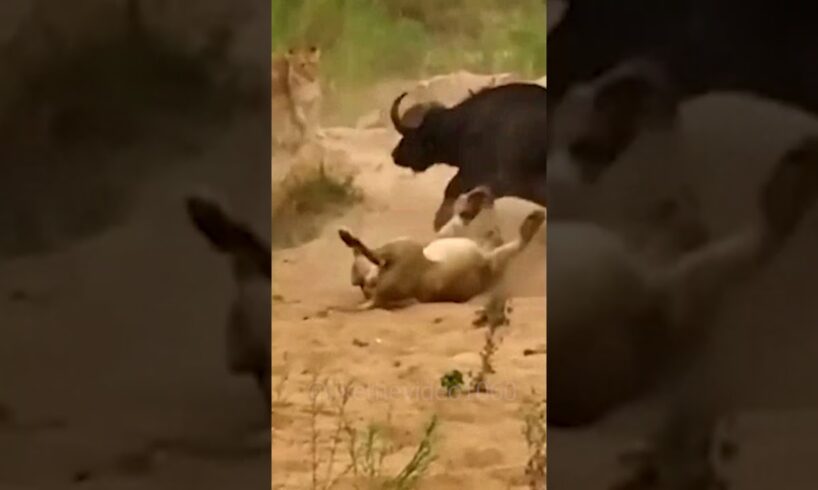
Thank you very much for the support.
https://www.buymeacoffee.com/likethevideo
The African buffalo (Syncerus caffer) is a large sub-Saharan African bovine. There are five subspecies that are recognized as being valid. Syncerus caffer caffer, the Cape buffalo, is the nominotypical subspecies, and the largest one, found in Southern and East Africa. S. c. nanus (the forest buffalo) is the smallest subspecies, common in forest areas of Central and West Africa, while S. c. brachyceros is in West Africa and S. c. aequinoctialis is in the savannas of East Africa. The adult African buffalo’s horns are its characteristic feature: they have fused bases, forming a continuous bone shield across the top of the head referred to as a “boss”. It is widely regarded as one of the most dangerous animals on the African continent, and according to some estimates[citation needed] it gores, tramples, and kills over 200 people every year.
The African buffalo is not an ancestor of domestic cattle and is only distantly related to other larger bovines. Its unpredictable temperament may have been part of the reason that the African buffalo has never been domesticated, unlike its Asian counterpart, the water buffalo. Natural predators of adult African buffaloes include lions, hyenas, and Nile crocodiles. As a member of the Big Five game, the Cape buffalo is a sought-after trophy in hunting.
The lion (Panthera leo) is a large cat of the genus Panthera native to Africa and India. It has a muscular, broad-chested body; short, rounded head; round ears; and a hairy tuft at the end of its tail. It is sexually dimorphic; adult male lions are larger than females and have a prominent mane. It is a social species, forming groups called prides. A lion’s pride consists of a few adult males, related females, and cubs. Groups of female lions usually hunt together, preying mostly on large ungulates. The lion is an apex and keystone predator; although some lions scavenge when opportunities occur and have been known to hunt humans, lions typically do not actively seek out and prey on humans.
The lion inhabits grasslands, savannas and shrublands. It is usually more diurnal than other wild cats, but when persecuted, it adapts to being active at night and at twilight. During the Neolithic period, the lion ranged throughout Africa and Eurasia from Southeast Europe to India, but it has been reduced to fragmented populations in sub-Saharan Africa and one population in western India. It has been listed as Vulnerable on the IUCN Red List since 1996 because populations in African countries have declined by about 43% since the early 1990s. Lion populations are untenable outside designated protected areas. Although the cause of the decline is not fully understood, habitat loss and conflicts with humans are the greatest causes for concern.
One of the most widely recognised animal symbols in human culture, the lion has been extensively depicted in sculptures and paintings, on national flags, and in contemporary films and literature. Lions have been kept in menageries since the time of the Roman Empire and have been a key species sought for exhibition in zoological gardens across the world since the late 18th century. Cultural depictions of lions were prominent in Ancient Egypt, and depictions have occurred in virtually all ancient and medieval cultures in the lion’s historic and current range.
source







The way that lion flipped back on those horns was pretty remarkable
پرخچہ اڑا دے پٹواری کھوتے کا…
水牛大戰群獅!
Nhin kĩ thấy môt con trâu bi chết rôi.con trâu này vì căm tưc ma dai dôt.đơi cho trâu mết cả đàn hổ bu vào thì khoe như trâu cũng chết.
Anh hùng găp anh hùng.môt đằng trả thù cho ban mà dám xong vào cả đàn hổ.nhìn con hô biểu diễn rất giỏi võ,chiu đau deo dai và môm luôn luôn hương vào cổ hong trâu.đàn hổ đang ăn no nếu đói thì trâu khoe mây cũng chết.vài con vít cổ .vít chân .nguy nhất là vài con cắn đuôi cắn hâu môn
Mày ăn thịt ban tao,tao quyết sống chết voi mày.Chúng tao ăn thit ban mày rôi,còn mày để hôm khác nhé
Good job King Buffalo👏❤️
❤❤❤❤❤❤❤❤❤❤❤❤❤❤❤❤❤❤❤❤❤❤❤❤❤❤❤❤❤❤😮😮😮😮❤❤❤❤❤❤❤❤❤❤❤❤❤❤❤❤❤❤❤❤❤❤❤❤❤❤
Por fin atacaron un león.
Bien búfalo!!!
Amém meu amigo bom dia
Misericórdia senhor 😮😮😮
🐃 🤬🤬🤬🤬🔥🔥🔥🔥🔥🔥🔥🔥🔥🔥🔥🔥🔥🔥👍🏽👍🏽👍🏽👍🏽👍🏽👍🏽👍🏽👍🏽👍🏽
برافوا عليكي 👌👏🏾👏🏾👏🏾👏🏾
Es rey en unas cosas pero no sabe ni conseguir comida y el tigre el solito ase todo 🤣😂😊
No que es el verdadero rey allí tienen a su rey león
❤❤❤good ❤❤jesa ko teha 😊😊koi mil. he geya. ❤❤gumeet singh❤❤❤❤
Um ele botou no chão,mad agora é melhor fugir que ainda tem varios.
Bravo buffalo keeping up
Timing shot
bullies
modar lu kena tanduk
Oooo bhago
Good job😂
Kkkkkkkkkkkll
Bixo bruto!!❤😂
Am loving this❤
А живодёры стоят и смотрят как стая Львов на одного😢
Trâu mà thông minh dũng cảm như này sư tử làm gì có cửa
It's 😡 👿 😤 🤬 ANGRY AS HELL=== DO BE IT!! THAT'S LIFE IN THE JUNGLE
Esse leão já era
Verygood
Very good 👍👍👍
Bloody lion took a lesson
Это не просто бык он мастер спорта по ушу важный тип
Poor lion. He got a balanced fighter
Вот это настоящий бык
E si deu mal cara
Kerbau klu punya akal tu harimau di injak perut nya dah mati
Good, lions are bully cowards
Sher log nich log hote hai .